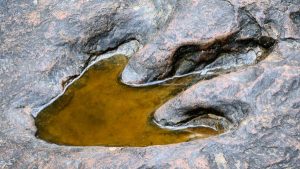
FOR just a few precious days every year a few lucky people can glance 66 million years into the past as the surf rolls back low enough on the Kimberley coast to reveal the wonderland of dinosaur footprints on its rocky ocean platforms.
The tide will be that low again in mid-July and a team of researchers, lead by University of Queensland’s Steve Salisbury, will again make its pilgrimage to Broome to build on their thrilling body of research.
It’s a massive project; they have 50 sites to study, each the size of a large quarry and each with a different dinosaur story.
It is also very exciting, Dr Salisbury says, because they are inching closer to creating a very accurate picture of how the Kimberley dinosaurs lived millions of years ago.
They have identified up to 20 species along a 200km stretch of coast, from the giant bird-claw-like imprint of the carnivorous Theropod to the stumpy Sauropod print and the distinctive four stubby-fingers and fat three-toed foot of the Stegosaurs.
Thanks to a precise combination of factors the prints have survived; the ground they walked had the right texture sediment to hold the print and subsequent sediment layers dried over the top to protect them.
The Kimberley sites are of global significance. According to researcher Dr Tony Tholborn (2012), nowhere else in the world have the comings and goings of dinosaurs moulded the landscape to the extent it has here.
However, this was not coastal cliff 130 million years ago when the dinosaurs trod it, but swampy sandy lagoons.
And there’s no doubt these were big animals. As Dr Salisbury clambered the slippery rock platforms on his 2015 expedition he could barely contain his excitement when he discovered what could be the largest dinosaur track in the world.
It was made by a Sauropod which could have stood up to eight metres at the hip and was estimated at 35m long. In comparison an Asian elephant is 6.5m long and just 2.7m high.
The sheer size of the dinosaurs is part of their appeal to so many people, Dr Salisbury says.
“They are colossal animals that really inspire the imagination—they are pretty spectacular,” he says.
“To think that things like this once existed and then to be able to see evidence whether its fossil bones or tracks, really inspires the imagination.
“Not just for little kids but big kids as well,” he says.
Note: The above post is reprinted from materials provided by ScienceNetwork WA.










